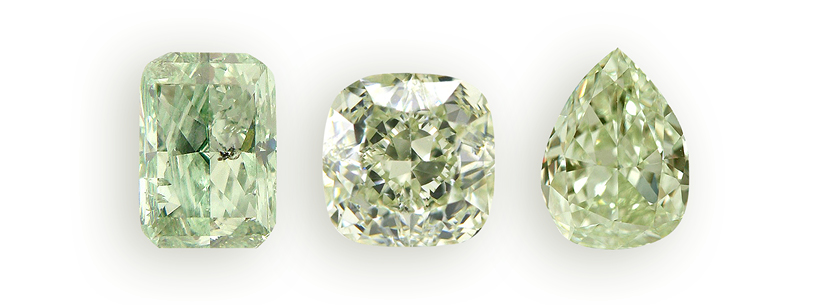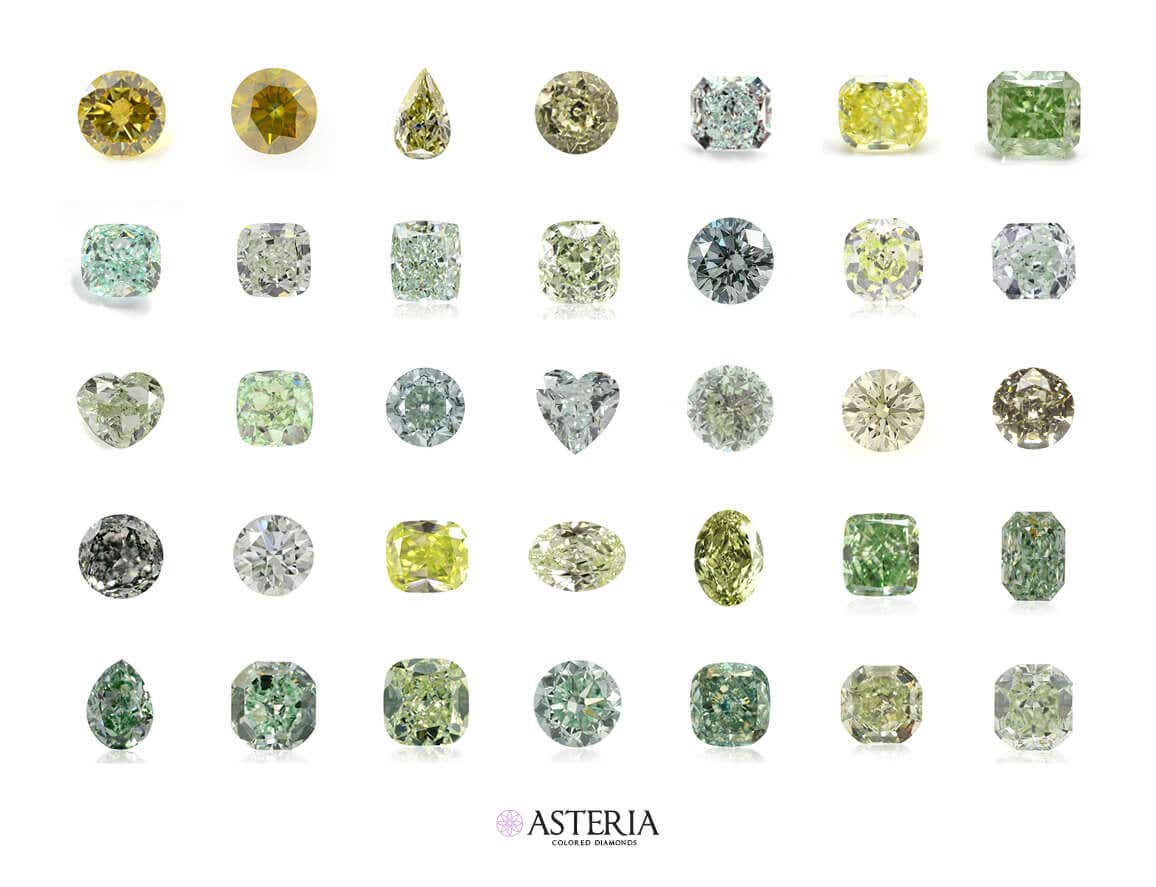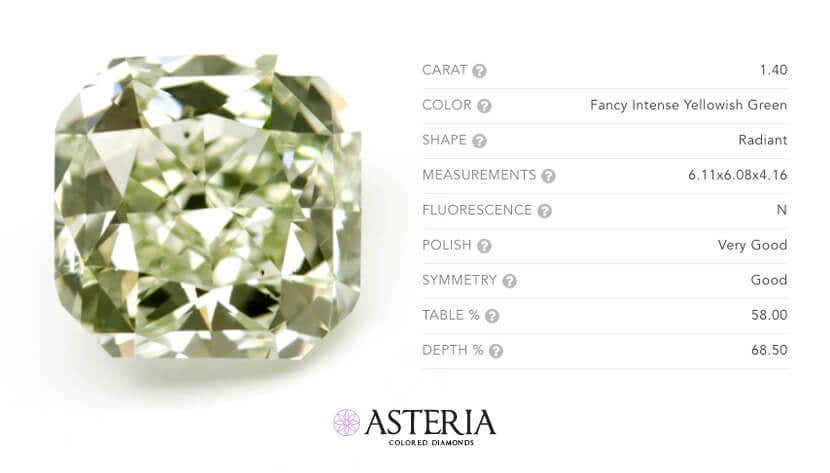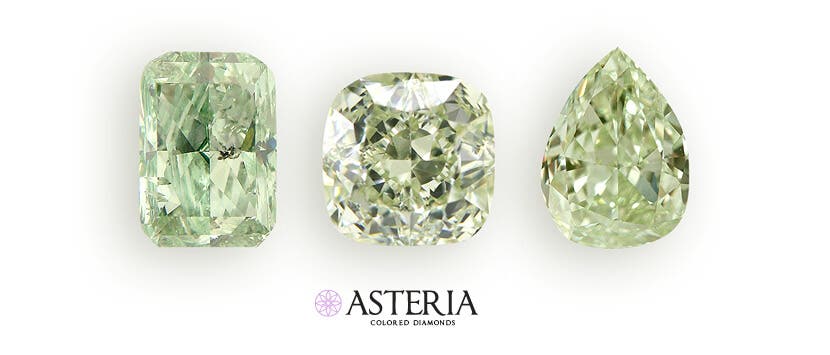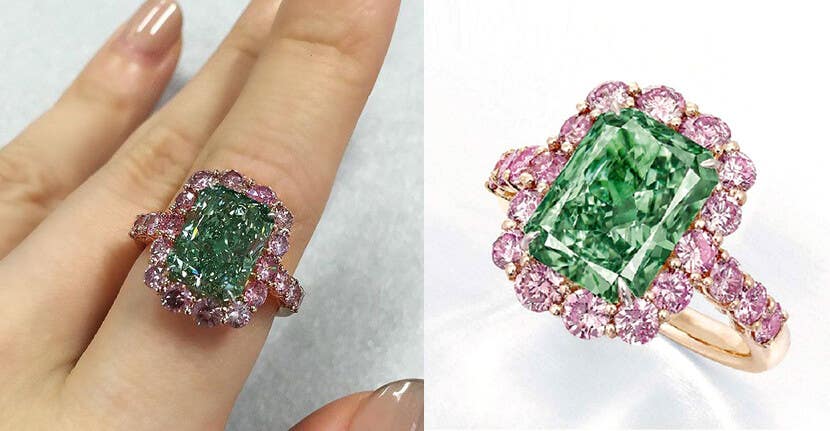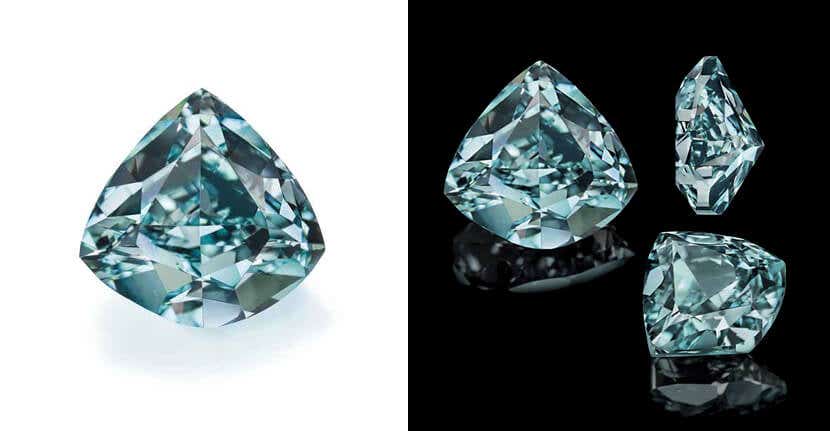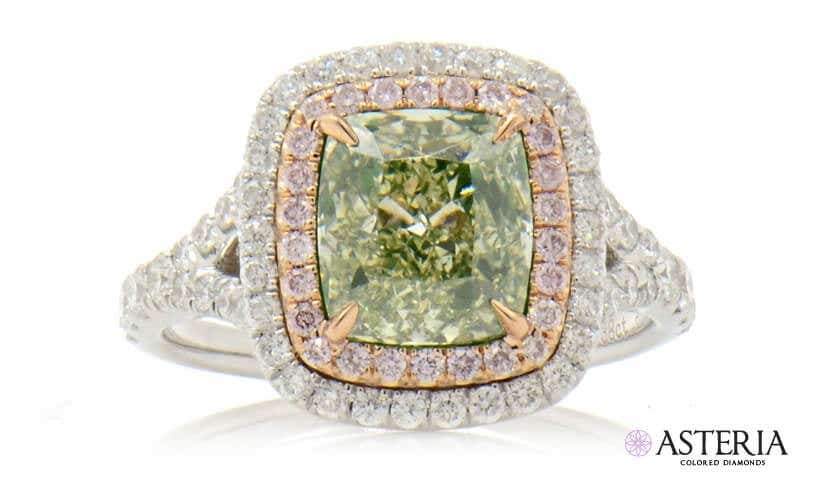Natural Green Diamonds Guide: Prices, authenticity, history & more | Asteria Colored diamonds
Green diamonds are among the most wondrous works of nature, created in a unique process spanning over millions of years. They include some famous breathtaking diamonds in unique vivid shades. The special story of green diamonds places them somewhere in the middle of the spectrum between the rarest of diamonds and those more commonly priced despite being very rare. How do they form? How much do they cost? How rare are they? All that and more, in this article.
How are natural green diamonds formed?
The green color in natural green diamonds originates from radiation the diamond crystal is exposed to during and after its formation. This formation process, be it of a colorless or fancy colored diamond, takes place under conditions of high pressure at a depth of 150-200 kilometers below the ground, at temperatures ranging from 1,000 to 2,000 degrees centigrade over millions of years.
While colored diamonds usually form as a result of a "contamination" in the pure carbon crystal (such as yellow diamonds, created by the presence of nitrogen molecules), the green color generally occurs after the diamond has completely crystalized, usually when it makes its way out from the deep underground through volcano vents and is thereby exposed to direct radiation.
The intensity of a diamond’s green color is significantly influenced by the type and duration of radiation it is exposed to, as well as its size.
Alpha particle radiation penetrates the diamond, affecting only its skin tone. Since this radiation does not penetrate into the body of the diamond, it acquires a rare and valuable, light green color.
In contrast, beta and gamma radiation are particulate radiations that can penetrate the diamond’s body and give it a deep green color at higher intensities, such as Fancy Intense, Fancy Deep & Fancy Vivid.
Green diamonds that come in contact with natural beta and gamma radiation are so rare, mainly because these conditions occur in nature in only 0.1% of cases.
Types of Natural Green Diamonds
1. Green Skin Tone - these diamonds feature the color green on the outer surface only and constitute the majority of green diamonds that were directly exposed to alpha radiation and took on a light tone at a relatively low intensity.
2. Green Body Color - these diamonds are absorbed in green throughout their body, and their hue is deeper and more intense due to direct exposure to beta and gamma radiation. They are considered very rare and desirable, especially among collectors.
You may also like our green diamonds for sale >
Fancy Green Diamond: Color & Pricing
The green diamond price, like all fancy colored diamonds, is influenced primarily by its color. The color of a Fancy diamond is the key parameter determining its rarity and pricing, and it leads the rest of the parameters by far. The color scale of the world's leading gemological institute, the GIA, is divided into 9 color intensities: Faint, Very Light, Light, Fancy Light, Fancy, Fancy Intense, Fancy Vivid, Fancy Deep, and Fancy Dark. Faint representing a bright and pastel shade and Fancy Deep representing a strong and deep green color.
The color definition is divided into three criterions: Hue, Tone, & Saturation.
Hue - represents the diamond’s dominant color. Although there might be secondary shades present as well, the hue signifies the main color according to which the diamond is categorized, in this case - Green.
Tone - represents the degree of light or darkness in the diamond, a feature that directly impacts the stone’s appearance. Tone does not appear in the GIA certificate as a separate parameter, but is rather part of the color definition. For those seeking to purchase a green diamond with a strong green hue and save money at the same time, it is recommended to purchase a diamond with a darker tone.
Saturation - saturation represents the intensity and strength of the color. Diamonds with a strong saturation are considered rarer and therefore more expensive.
Green Diamonds Secondary Hues & Pricing
Secondary hues found in green diamonds are yellow, brown, gray, and blue. Most green diamonds have a secondary hue (sometimes two) that affects the pricing of the stone.
Pictures green diamonds color combinations: Left to Right
Line 1: fancy deep brownish greenish yellow diamond, fancy deep brownish greenish yellow diamond, fancy grayish yellowish green diamond, fancy light grayish yellowish green diamond, fancy greenish blue diamond, fancy intense green yellow diamond, fancy vivid green diamond
Line 2: fancy intense bluish green, fancy light yellowish green diamond, fancy yellowish green diamond, fancy light yellowish green diamond, light green diamond, fancy light yellow green diamond, fancy light yellowish green diamond
Line 3: fancy light yellowish green diamond, fancy intense yellowish green diamond, fancy green diamond, light green diamond, fancy light yellowish green diamond, very light green diamond, fancy gray yellowish green diamond
Line 4: fancy grayish green diamond, light green diamond, fancy intense green diamond, light green diamond, fancy grayish greenish yellow diamond, fancy vivid green diamond, fancy intense green diamond
Aline 5: fancy vivid bluish green diamond, fancy intense bluish green diamond, fancy intense green diamond, fancy intense green diamond, fancy intense blue green diamond, fancy yellow green diamond, fancy yellow green diamond.
_____________
The impact on the pricing is determined by the type of the secondary hue, or in other words, if the diamond’s secondary hue is less rare than the green hue, like yellow or brown, it's value will be lower. But if the secondary hue is the rare, coveted, and popular blue color - the value and popularity of the green diamond will soar.
As always with fancy colored diamonds, the primary hue appears last in the color definition of green diamonds, with the secondary hues preceding it on the certificate. The definition of the primary hue (for example: Blue/Blueish) indicates the degree of the color’s dominance.
For example: Yellow Green diamond signifies a yellow hue with relatively high dominance (40%) against the primary green hue (60%), while Yellowish Green diamond signifies a less dominant yellow hue (25%) against the primary green hue (75%).
* These percentages are for illustration purposes only and do not represent actual statistics.
Since most green diamonds have one or more additional hues, pure green diamonds, especially those with natural body tones, are considered rarer and therefore priced higher, unless the secondary hue is blue with the same intensity.
Distribution of color in green diamonds
Since the diamond’s green color is created by direct exposure to radiation, only the areas that are subject to such exposure will acquire a green hue. Subsequently, most green diamonds exposed to a superficial alpha radiation that doesn’t penetrate the diamond’s casing have an uneven color distribution, making green diamonds with equal distribution particularly rare. Compared to Skin Tones diamonds, green diamonds exposed to beta and gamma radiation that penetrates the diamond’s body usually get not only a spectacular and extremely rare color intensity, but also a more even and uniform color distribution that enriches the diamond’s appearance, enhances the color, and gives it a much higher monetary value.
Loose Green Diamonds: Pricing by Carat, Clarity & Cut
The 4 C’s are the parameters used by gemologists for grading white and fancy colored diamonds, and they include: Color, Carat, Clarity & Cut. Color, as mentioned above, is the most important parameter influencing the diamond’s definition and pricing. However, the other three also influence the diamond’s definition and pricing and can help you understand its characteristics.
For example, the higher the carat (the diamond's weight) the exponentially higher its value rises, because the price per carat of a green diamond increases significantly as the overall weight of the diamond rises.
The clarity parameter is designed to grade the amount and type of any existing defects in the diamond and thus indicate the quality of the shine and reflection. The clarity scale consists of nine levels divided into 6 groups defined by the GIA. The difference between grade levels within the group is relatively negligible, but the difference between groups is more considerable.
FL - Flawless
IF - Internally flawless
VVS1 & VVS2 - Very, very slightly included
VS1 & VS2 - Very slightly included
SI1 & SI2 - Slightly included
I1 & I2 – Included
Since most of the flaws are so small that they are invisible to the human eye, it’s possible to save money by purchasing a fancy colored diamond with a lower clarity level, such as SI1 for example. But if we decide to do that, we should make sure the clarity level we choose does not impair the diamond’s color, shine, or reflection, or else we might miss the whole point in buying a rare and ever-lasting natural treasure like this.
The last parameter that may affect the definition and pricing of a green diamond is the cut. Many believe that cut and shape are the same thing, whereas they are actually two different aspects that complement each other. The diamond’s cut represents the way the diamond polisher cut the finished diamond from the rough stone. A good cut highlights the qualities of the diamond, with an emphasis on it's color, shiny polish, and flattering symmetry.
Cut & Shape - What's the difference?
The diamond polisher chooses the right shape for the green diamond before cutting it, and during the cutting process itself the other qualities mentioned above, such as polishing, symmetry, and clean cutting, are implemented as well.
For example, any diamond polisher knows that a round shape is not suitable for fancy colored diamonds. This shape is excellent for reflecting white light and therefore is used frequently when cutting white diamonds. But when it comes to fancy colored diamonds whose greatest value is their color (the more intense and vivid the better), it is probably the poorest choice, because the white light weakens the color. However, shapes like Radiant, Pear, Cushion, etc. are more preferable for green diamonds and fancy colored diamonds in general.
How rare are green diamonds?
The formation of green diamonds in nature is a rather rare process, especially regarding those with intense colorful bodies. This is evident in the auction houses, where although they’ve been selling diamonds of various colors for 40 years, only twice have they ever sold Fancy Vivid green diamonds for record-breaking sums of $1.222 million and $3.18 million per carat. Although they are equally rare and sold for similarly huge sums, green diamonds are not graded in the same group as the three rarest diamond colors: red, blue, and pink, primarily because they are not as popular as them.
Fancy Vivid green diamond is the rarest and most intense one, but because the demand for blue, red, and pink diamonds is higher, its price per carat is relatively lower. Besides that, the other green hues have never been abundant, and included mainly diamonds graded Fancy or Intense and below. As a result, green diamonds are coveted by collectors who want to own rare and stunning diamonds like the green ones without having to sell them again later, as opposed to those who see it as an investment opportunity.
The world’s most famous green diamond
Drezden Diamond - the most recognized and famous green diamond, shown on display for the last 200 years in Saxony, Germany, from whose capital it got its name. This pear-shaped diamond weighs 41.60 carats, boasting a deep and evenly distributed green hue and the highest clarity level of VS1 - all these features, as well as the fascinating history behind it, make the Dresden Diamond the world’s most famous diamond.
Aurora Green – in May 2016 the Aurora Green was sold at a historical record price of $16.8 million at an auction held in Japan. Weighing 5.07 carat, it’s the largest Fancy Vivid green diamond ever sold. The green stone, boasting a VS2 clarity level and embedded with a gold ring studded with round pink diamonds, broke the previous record set just one month earlier by the sale of 'The Ocean Dream'.
The Ocean Dream – this Deep Blue green diamond weighing 5.51 carat was sold for $8.9 million. The deep and rare color of the shield-shaped diamond makes it one of the rarest stones, examined and approved by the GIA as a natural diamond that acquired its special color in an underground radioactive process spanning over millions of years.
Identifying natural green diamonds
Green diamonds are tested and diagnosed at top laboratories of leading geology institutes such as the Gemological Institute of America (GIA), which employ advanced technology, thorough testing techniques, and specialized experts to determine the diamond’s origin, color intensity, color distribution, etc. Then all the information is registered in a unique and original certificate for each diamond.
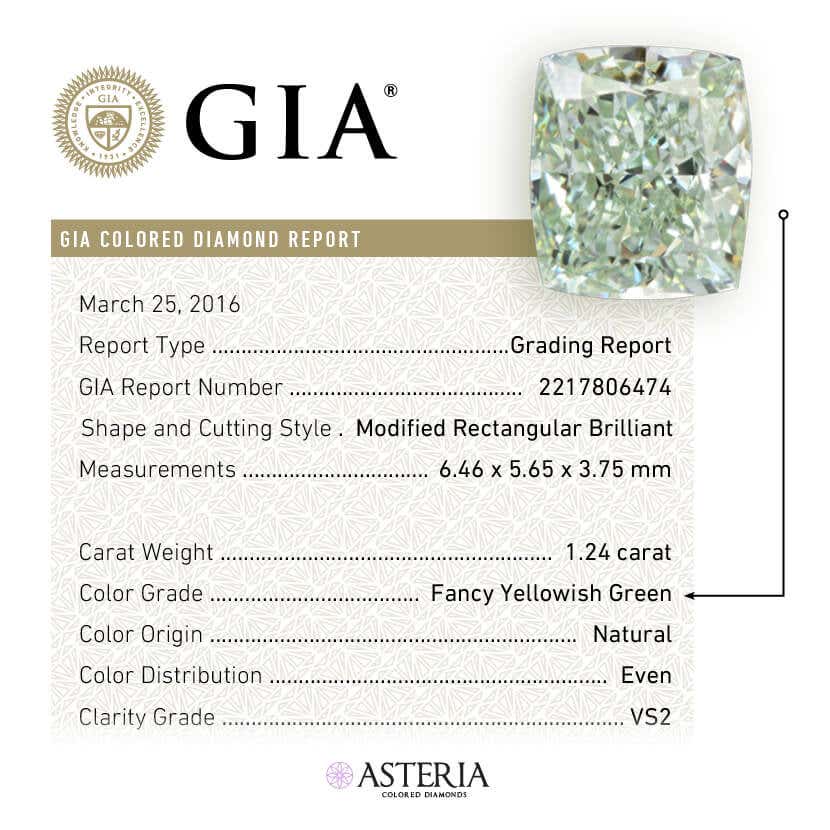
The main challenge professional gemologists face when determining whether a green diamond is natural or not, stems primarily from the fact that alpha, beta, and gamma radiation that occurs naturally in the depths of the earth and volcanoes can be artificially imitated in laboratories.
To cope with this challenge, the leading gemology institutes, especially the GIA, developed thorough, in-depth, and uncompromising lab tests that manage to rule decisively whether the diamond's green color was created in a natural or artificial process.
For this reason, it is highly recommended to buy diamonds with an original GIA certificate, so you can rest assure that your purchase is authentic and worth the value, especially when buying green diamonds.
Green Diamond Engagement Ring
If you wish to give your fiancée an ever-lasting diamond whose extraordinary rarity will reflect the power of your love, the green diamond may be the right choice for you, since it will be cheaper than the rarest popular diamonds.
With a color symbolizing health, fertility, renewal, good fortune, and money, combined with spiritual balance and connection to the heart chakra, as it commonly represents in the Far East, the Green Diamond Engagement Ring will be at the same time a smart and sensitive choice.
Green diamonds fit in beautifully in gold rings that emphasize their color, and can be combined with small diamonds in other colors like pink, yellow, or even black to generate contrast in a one-of-a-kind engagement ring.


